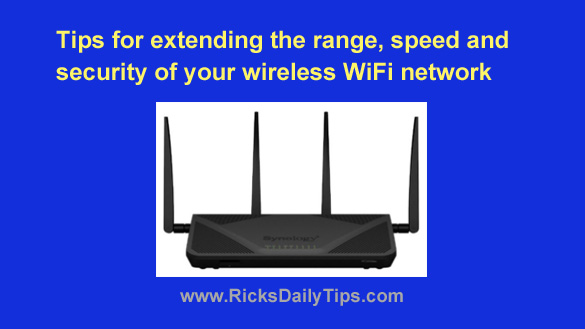 Note: The links in this post are affiliate links.
Note: The links in this post are affiliate links.
Wireless routers make it very easy to share your high speed Internet connection with guests and family members.
They also make it easy to use your laptop or mobile devices in any room in the house without running cables all over the place.
But if you live in a large house and/or have multiple devices all using the Internet at the same time, chances are your WiFi connection is weaker and slower than it could be due to obstructions, distance and bandwidth limitations.
The good news is you don’t have to live with a slow or range-limited wireless network. There are several things you can do to extend the range of your wireless router’s WiFi signal, boost your connection speed and make your WiFi network more secure:
1 – If you have a large house, try moving the router to a room that’s located more or less in the middle of it.
If for some reason you are unable to move the router closer to the middle of your home, adding a powerline Wifi extender could help extend both wireless and wired connections to the far reaches of your home.
If one or more of your devices is a desktop PC that doesn’t have built-in wireless capability, you can always add it by purchasing a USB WiFi adapter.
The nominal expense will be well worth it after you blanket your the entire house with a strong WiFi signal.
2 – Once you have selected the best room to house your router, place it on a high shelf to prevent furniture and other household items from blocking the WiFi signal.
3 – If your router is located in close proximity to one or more computers (including laptops), connect them to the router via a LAN cable. This will free up the available WiFi bandwidth for use by those devices that MUST connect wirelessly.
4 – Try changing the router’s channel to one that is less congested (the procedure for doing this varies by manufacturer and model so you’ll need to consult your manual for instructions).
5 – Make sure your router has the latest firmware update installed (again, consult the manual for instructions, and follow them to the letter).
6 – If your router is more than three years old, consider replacing it with a new, state-of-the-art router in order to take advantage of newer, faster and more secure technologies.
7 – Set up your router to use a secure, encrypted connection and add a secure, yet easy to remember password (aka network access key) in order to keep freeloaders from piggy-backing off your WiFi connection and clogging up the “data pipe”.
8 – Use the free Fing Network Tools app to make sure no one is piggy-backing off your WiFi network. In addition to slowing down your network, piggy-backers also pose a serious potential security threat.
9 – Check your actual download and upload Internet speeds with SpeedTest.net to make sure you’re getting the speeds you’re paying for every month. If both of those tests determine that your connection is a lot slower than it should be you can contact your ISP and ask them to track down the problem and fix it.
You don’t have to try all of the above, but the more of them that you can complete the more satisfaction you’re likely to receive from your WiFi connection.